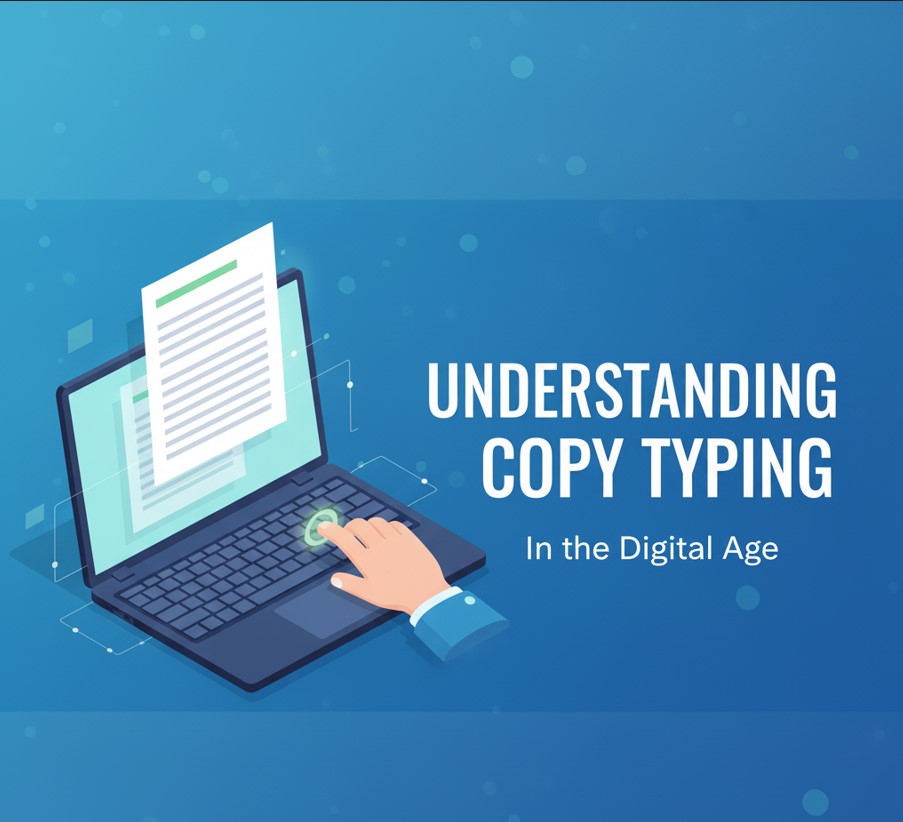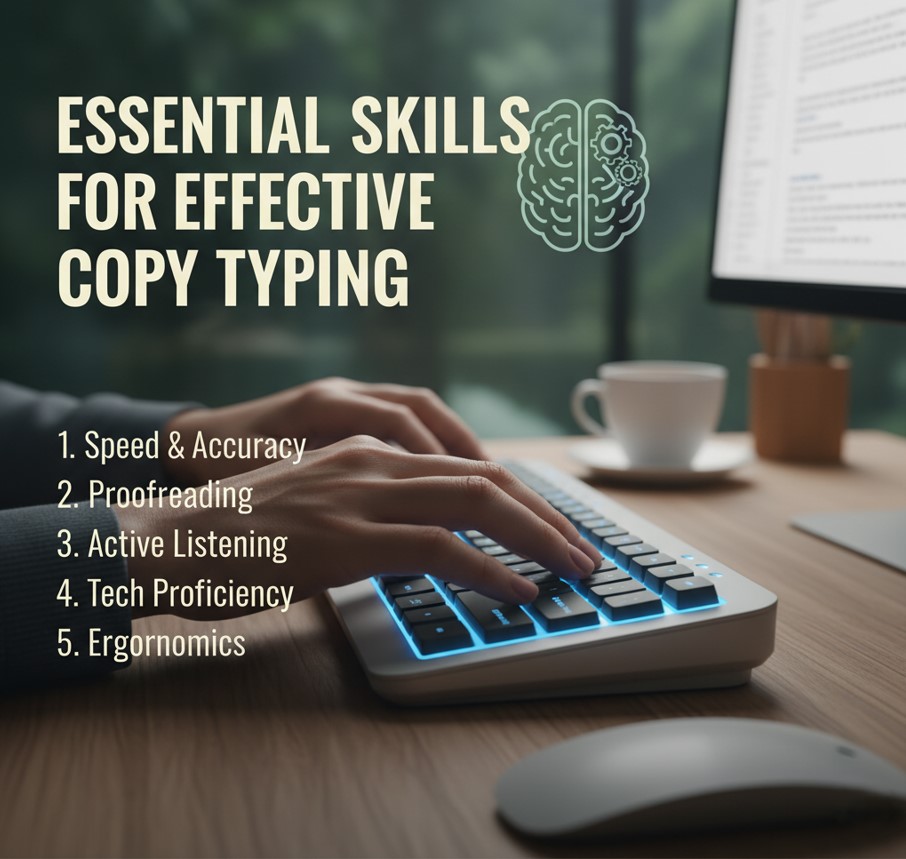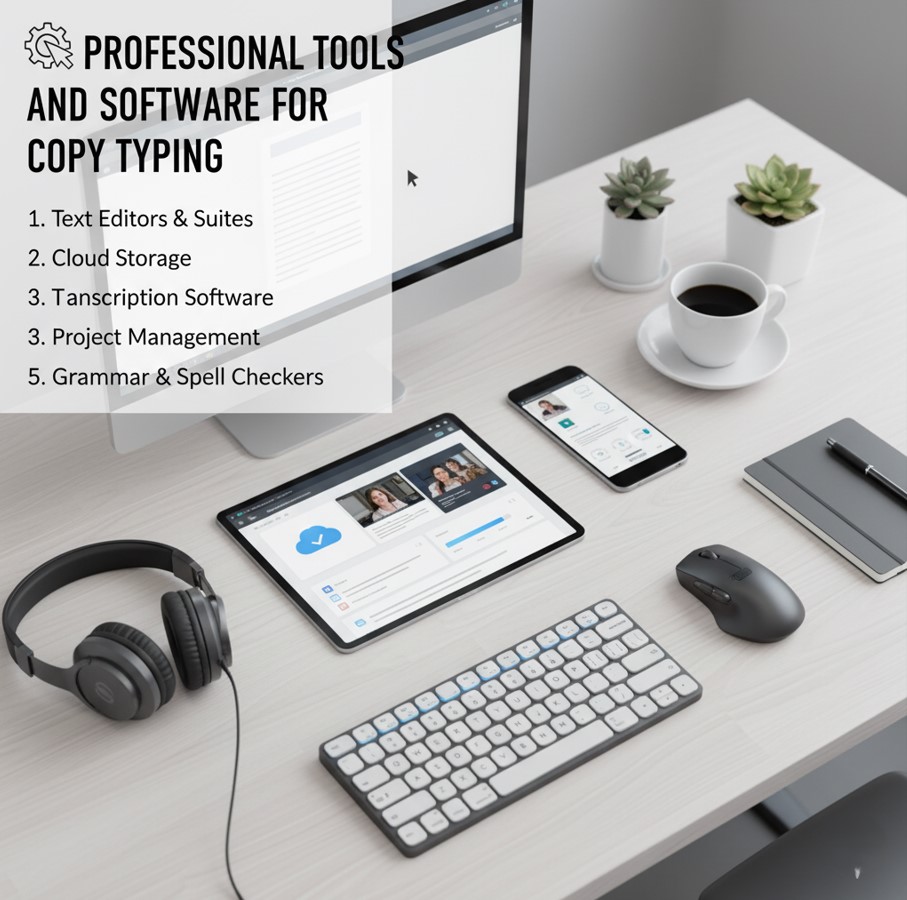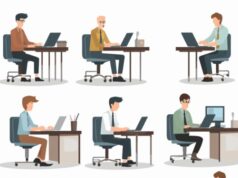Copy typing is one of the basic skills of our information-driven world. In the core, copying typing involves introducing the text from a source document in a digital format with accuracy and efficiency. Although displayed directly, this process requires technical skill, focus on expansion, and a unique combination of stability that makes it invaluable in many professional contexts.
Understanding Copy Typing in the Digital Age
In today’s digital scenario, where information management has become increasingly important, the ability to move materials accurately from physical to digital formats is in high demand. Organizations in sectors rely on copy dating to digitize the archives, create sought-after databases, and ensure information access. Away from becoming obsolete from technological progress, Copy Typing has evolved to include new devices and techniques that increase productivity and accuracy.
This broad guide examines everything you need to know about copying – from original techniques and best practices to career opportunities and professional development paths. Whether you want to improve your existing skills, pursue employment in data registration, or just understand this essential digital skill, this article will provide valuable insight into the world of copy typing.

What Exactly Is Copy Typing?
Definition and Core Concepts
Copy typing refers to the process of transferring text from one medium to another, typically from a physical document, image, or PDF into an editable digital format. This task differs from original content creation as it focuses on reproducing existing text rather than generating new material.
The fundamental requirements of copy typing include:
- Accuracy: Ensuring the copied text perfectly matches the source material
- Speed: Completing the task efficiently without sacrificing quality
- Formatting consistency: Maintaining the original document’s structure and presentation
- Language proficiency: Understanding the content well enough to avoid errors
Historical Evolution of Copy Typing
Copy typing has undergone a significant transformation throughout history:
- Typewriter Era: Copy typing originated with mechanical typewriters, where typists transferred handwritten text to typed documents.
- Early Digital Phase: The introduction of computers and word processors in the 1980s revolutionized copy typing, allowing for easier corrections and formatting.
- Modern Digital Copy Typing: Today’s copy typing integrates advanced tools like OCR (Optical Character Recognition), specialized software, and cloud-based platforms that enhance efficiency and collaboration.
The evolution continues as AI and machine learning technologies begin to supplement—though not entirely replace—human copy typing capabilities, particularly for complex documents requiring judgment and context understanding.
Essential Skills for Effective Copy Typing

Typing Speed and Accuracy Balance
The cornerstone of professional copy typing lies in balancing speed with accuracy. Industry standards typically expect:
- Speed: Professional copy typists generally maintain 50-80 words per minute (WPM)
- Accuracy: Error rates below 1% are considered acceptable in professional environments
Achieving this balance requires regular practice and assessment. Tools like typing tests can help measure your current abilities and track improvement over time. Remember that consistent accuracy ultimately proves more valuable than pure speed, as error correction often consumes more time than slightly slower typing.
Touch Typing Mastery
Touch typing—the ability to type without looking at the keyboard—forms the foundation of efficient copy typing. This skill involves:
- Finger positioning: Each finger is responsible for specific keys
- Home row positioning: Fingers rest on the ASDF (left hand) and JKL (right hand) keys
- Muscle memory development: Typing becomes automatic through consistent practice
Mastering touch typing dramatically improves both speed and accuracy while reducing physical strain during extended typing sessions. Various online courses and applications can help develop this fundamental skill.
Document Formatting Skills
Beyond simple text reproduction, professional copy typing often requires maintaining or creating specific document formats. Key formatting skills include:
- Paragraph structuring: Preserving indentation, spacing, and organization
- Table reproduction: Accurately recreating tabular data
- Typography management: Handling different fonts, sizes, and styling (bold, italic, underline)
- Page layout: Maintaining margins, headers, footers, and pagination
Proficiency with word processing software like Microsoft Word, Google Docs, or specialized industry tools greatly enhances formatting capabilities.
Professional Tools and Software for Copy Typing

Word Processing Software
The most common platforms for copy typing include:
- Microsoft Word: Industry-standard with comprehensive formatting capabilities
- Google Docs: Excellent for collaborative work and cloud storage
- LibreOffice Writer: Free alternative with robust formatting features
Each offers different strengths, and professional copy typists often develop proficiency across multiple platforms to accommodate client preferences.
Specialized Copy Typing Tools
Beyond standard word processors, specialized tools can significantly enhance productivity:
- Text expanders: Programs that convert short abbreviations into longer phrases or paragraphs
- Keyboard macros: Customizable shortcuts for repetitive typing tasks
- Grammar and spelling checkers: Tools like Grammarly or ProWritingAid that catch errors in real-time
- Dictation software: Programs that convert spoken words to text, useful for transcription tasks
According to a study by the American Management Association, utilizing specialized tools can increase copy typing productivity by up to 30%.
OCR Technology Integration
Optical Character Recognition (OCR) technology has revolutionized copy typing by automating the conversion of scanned documents or images into editable text:
- Desktop OCR software: Programs like ABBYY FineReader or Adobe Acrobat Pro
- Online OCR services: Web-based tools like OnlineOCR or Google Drive’s built-in OCR
- Mobile OCR apps: Smartphone applications that capture and convert text on the go
While OCR significantly reduces manual typing needs, professional copy typists remain essential for verifying accuracy, correcting OCR errors, and handling complex formatting that automated systems struggle with.
Techniques to Improve Copy Typing Efficiency
Ergonomic Considerations
Proper ergonomics not only prevents injury but also improves typing efficiency:
- Proper sitting posture: Back straight, feet flat on floor, arms at 90-degree angles
- Keyboard positioning: Slightly below elbow level to reduce wrist strain
- Monitor placement: Eye level, arm’s length away to reduce neck strain
- Regular breaks: Following the 20-20-20 rule (every 20 minutes, look at something 20 feet away for 20 seconds)
Implementing ergonomic practices helps maintain productivity during lengthy copy typing sessions and prevents repetitive strain injuries that could impact long-term career sustainability.
Cognitive Techniques for Error Reduction
Mental approaches that improve accuracy include:
- Chunking: Processing text in meaningful segments rather than individual characters
- Proofreading strategies: Reading backwards or aloud to catch errors
- Focus management: Minimizing distractions in the work environment
- Mindfulness practices: Brief meditation or breathing exercises to maintain concentration
Research published in the Journal of Applied Psychology suggests that implementing strategic cognitive techniques can reduce error rates by up to 25%.
Time Management for Large Projects
Tackling substantial copy typing projects requires effective time management:
- Project segmentation: Breaking large documents into manageable sections
- Timed work intervals: Using techniques like the Pomodoro method (25 minutes of work followed by a 5-minute break)
- Progress tracking: Monitoring completion rates to maintain motivation and meet deadlines
- Prioritization: Identifying critical sections requiring extra attention or earlier completion
Copy Typing in Various Professional Contexts
Data Entry and Administrative Support
In administrative environments, copy typing typically involves:
- Form completion: Transferring information from paper forms to digital databases
- Correspondence digitization: Converting physical letters or notes into digital formats
- Report compilation: Combining information from multiple sources into standardized formats
- Record maintenance: Updating existing digital records with new information
These tasks form the backbone of information management in many organizations, making accurate copy typing essential for operational efficiency.
Read our latest case study showcasing how effective data Classification transformed a client’s operations.
Legal and Medical Transcription
Specialized industries require domain-specific copy typing skills:
- Legal documents: Requiring precise formatting and terminology understanding
- Medical records: Demanding familiarity with medical terminology and strict confidentiality
- Court transcripts: Necessitating verbatim accuracy and specialized formatting
- Research data: Involving technical terminology and data organization
These specialized fields typically offer higher compensation but require additional training and certification to ensure domain knowledge accuracy.
Academic and Publishing Applications
In academic contexts, copy typing supports:
- Research documentation: Digitizing handwritten notes or older publications
- Manuscript preparation: Formatting documents according to specific publication guidelines
- Bibliography compilation: Creating standardized reference lists from various sources
- Thesis and dissertation formatting: Ensuring compliance with institutional requirements
According to the Society for Scholarly Publishing, specialized academic copy typing skills remain in high demand despite technological advancements in digital publishing.
Quality Assurance in Copy Typing
Proofreading Methodologies
Effective proofreading techniques include:
- Multiple pass approach: Checking for different error types in separate readings
- Comparative proofreading: Directly comparing source and copy side-by-side
- Text-to-speech verification: Using screen readers to identify errors missed visually
- Fresh eyes review: Taking breaks before final proofreading to gain perspective
Implementing structured proofreading protocols can reduce error rates to below 0.5%, a standard expected in professional publishing environments.
Error Tracking and Improvement
Systematic approaches to error reduction include:
- Error logging: Tracking common mistakes to identify patterns
- Targeted practice: Focusing on specific problem areas (numbers, proper nouns, etc.)
- Self-assessment tools: Using typing tests that highlight particular weaknesses
- Continual learning: Regularly updating skills through courses and professional development
By analyzing error patterns, copy typists can implement targeted improvement strategies rather than generic practice.
Quality Standards in Different Industries
Industry-specific quality expectations vary considerably:
- Financial services: Near-zero tolerance for numerical errors
- Publishing: Adherence to style guides and formatting consistency
- Healthcare: Absolute accuracy in patient information and medical terminology
- Legal services: Precise formatting and verbatim accuracy for legal documents
Understanding industry-specific standards helps copy typists prioritize quality control efforts appropriately for their work context.
Career Development in Copy Typing
Professional Certification Options
Formal credentials that enhance employability include:
- Certified Administrative Professional (CAP): Broad certification covering administrative skills, including copy typing
- Microsoft Office Specialist (MOS): Certification in Microsoft Word and related applications
- Medical Transcriptionist Certification: Specialized in healthcare documentation
- Legal Transcription Certification: Focused on legal document preparation
Certifications typically require passing standardized examinations and demonstrating minimum speed and accuracy benchmarks.
Freelance and Remote Opportunities
The gig economy has expanded opportunities for copy typing professionals:
- Freelance platforms: Websites like Upwork, Fiverr, and Freelancer connect typists with clients
- Virtual assistant agencies: Companies employing remote administrative professionals
- Specialized transcription services: Businesses focusing on legal, medical, or academic transcription
- Content conversion services: Organizations specializing in digitizing physical archives
Remote copy typing positions have grown by approximately 40% since 2019, according to the Bureau of Labor Statistics.
Career Progression Paths
Copy typing skills can lead to advanced career opportunities:
- Executive assistant roles: Supporting high-level executives with complex documentation needs
- Document management specialists: Overseeing organizational information systems
- Content production coordinators: Managing document workflow in publishing environments
- Data integrity analysts: Ensuring accuracy across information systems
By combining copy typing proficiency with additional skills like project management or technical expertise, professionals can advance to higher-paying positions with greater responsibility.
Future Trends in Copy Typing
Automation and AI Integration
Emerging technologies are reshaping the copy typing landscape:
- Advanced OCR capabilities: Increasingly accurate text recognition even for handwritten documents
- AI-assisted proofreading: Tools that identify context-based errors beyond simple spelling
- Voice-to-text advancements: More accurate dictation software requiring less human correction
- Specialized industry solutions: Tools designed for specific document types (legal, medical, technical)
Rather than replacing human copy typists, these technologies are shifting the role toward quality control, formatting expertise, and handling complex documents beyond AI capabilities.
Evolving Skill Requirements
Future copy typing professionals will need an expanded skill set:
- Technical adaptability: Facility with evolving software and platforms
- Critical thinking: Judgment in reviewing AI-generated content
- Specialized knowledge: Domain expertise that contextualizes information
- Collaborative abilities: Working effectively with automated systems and remote teams
According to Forbes, the most successful copy typing professionals will be those who embrace technological change while developing uniquely human capabilities.
Sustainable Career Development
To maintain relevance in an evolving field, copy typing professionals should focus on:
- Continuous learning: Regularly updating technical skills and industry knowledge
- Specialization: Developing expertise in high-value niches requiring human judgment
- Service expansion: Offering complementary skills like formatting, editing, or content management
- Client relationship development: Building trust and understanding specific client needs
By positioning themselves as information management professionals rather than simply typists, practitioners can ensure sustainable career growth.
The Enduring Value of Copy Typing Skills
Despite technological progress, effective copy typing is still an essential ability in many professional contexts. The combination of accuracy, formatting of competence, and domain knowledge provides value that the automatic solution cannot completely repeat.
For individuals who want to enter the field or increase existing skills, focus on speed and accuracy when developing special knowledge, as it is the strongest basis for success. Since information management is required, people with strong copying skills will find themselves equipped with a versatile skill that adapts to changing workplace requirements.
Whether you pursue copying as a primary career path or an additional skill in a broad professional role, the principles and practices mentioned in this guide give a roadmap for development and success in this permanent digital skill.










